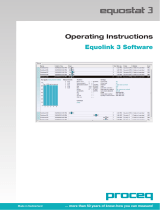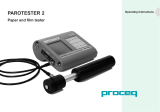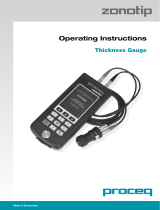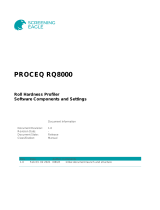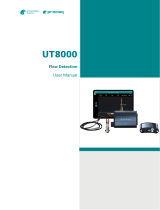Page is loading ...

Swiss Precision since 1954
60 Years of Innovation60 Years of Innovation
Operating Instructions

© 2017 Proceq SA 2
Table of Contents
1. Safety and Liability ....................................................4
1.1 General Information ............................................................. 4
1.2 Liability .................................................................................. 4
1.3 Safety Instructions ............................................................... 4
1.4 Correct Usage ...................................................................... 4
1.5 Optimizing Performance of the Battery System ............... 4
2. Getting Started ...........................................................5
2.1 Installation ............................................................................ 5
2.2 Main Menu ............................................................................ 6
3. Measurement .............................................................7
3.1 Performing Measurements ................................................. 7
3.2 Measurements Screen ...................................................... 10
3.3 Measuring Methods .......................................................... 12
3.4 Instrument Verification / Daily Performance Check ....... 24
3.5 Use of barcode scanners .................................................. 24
4. Settings ....................................................................25
4.1 Measurements ................................................................... 25
4.2 Verification (Performance & Uncertainty Check) ............ 27
4.3 Conversions (Hardness Conversions) ............................. 28
4.4 Reporting ............................................................................ 28
5. Data (Explorer) .........................................................29
5.1 Measurements ................................................................... 29
5.2 Verifications ........................................................................ 30
5.3 Mappings ............................................................................ 30
6. Wizards .....................................................................31
6.1 Measurement Wizard ........................................................ 31
6.2 Device Verification ............................................................. 31
6.3 Impact Direction Calibration (Leeb only) ......................... 32
6.4 Conversion Curve Creation .............................................. 32
6.5 Combined Method ............................................................. 34
6.6 Mapping Wizard ................................................................. 34
7. Information ...............................................................35
7.1 Documents ......................................................................... 35
7.2 Upload PDF-Files from an USB-stick .............................. 35
8. System ......................................................................36
8.1 Features .............................................................................. 36
8.2 Probes ................................................................................ 37
8.3 Hardware ............................................................................ 37
8.4 Date & Time ........................................................................ 37
8.5 Language ............................................................................ 37
8.6 Device information ............................................................. 37
9. Maintenance and Support .......................................38
9.1 Maintenance....................................................................... 38
9.2 Support Concept ............................................................... 39

© 2017 Proceq SA 3
9.3 Standard Warranty and Extended Warranty ...................... 39
9.4 Disposal ................................................................................. 39
10. Troubleshooting ......................................................... 40
10.1 Incorrect Measurements / Failed Performance Check ..... 40
10.2 No Reading Displayed ......................................................... 41
10.3 Battery ................................................................................... 42
10.4 Touchscreen Calibration ...................................................... 42
11. Equotip Link Software ............................................... 42
11.1 Starting Equotip Link ............................................................ 42
11.2 Application Settings ............................................................ 42
11.3 Connecting to an Equotip 550 Touchscreen Unit ............. 43
11.4 Connection to Portable Rockwell Probe ............................ 43
11.5 Adjusting the Settings .......................................................... 43
11.6 Exporting Data ...................................................................... 44
11.7 Exporting and Importing of Setting Profiles ....................... 45
11.8 Exporting and Importing of Conversion Curves ................ 45
12. Technical Specifications ............................................ 45
12.1 Instrument ............................................................................. 45
12.2 Power Supply ........................................................................ 46
12.3 Equotip Leeb Impact Devices ............................................. 46
12.4 Equotip Portable Rockwell Probe ....................................... 47
12.5 Equotip UCI Probe ................................................................ 47
13. Standards & Guidelines ...........................................47
14. Ordering Information ...............................................48
14.1 Units .................................................................................... 48
14.2 Impact Devices & Probes ................................................. 49
14.3 Parts and Accessories ...................................................... 49
14.4 Test Blocks ......................................................................... 50

4 © 2017 Proceq SA
1. Safety and Liability
1.1 General Information
This manual contains important information on the safety, use and main-
tenance of the Equotip 550. Read through the manual carefully before the
first use of the instrument.
1.2 Liability
Our “General Terms and Conditions of Sales and Delivery” apply in all
cases. Warranty and liability claims arising from personal injury and dam-
age to property cannot be upheld if they are due to one or more of the
following causes:
• Failure to use the instrument in accordance with its designated use as
described in this manual.
• Incorrect performance check for operation and maintenance of the in-
strument and its components.
• Failure to adhere to the sections of the manual dealing with the per-
formance check, operation and maintenance of the instrument and its
components.
• Unauthorised modifications to the instrument and its components.
• Serious damage resulting from the effects of foreign bodies, accidents,
vandalism and force majeure.
All information contained in this documentation is presented in good faith
and believed to be correct. Proceq SA makes no warranties and excludes
all liability as to the completeness and/or accuracy of the information.
1.3 Safety Instructions
The equipment is not allowed to be operated by children or anyone under
the influence of alcohol, drugs or pharmaceutical preparations. Anyone
who is not familiar with this manual must be supervised when using the
equipment.
• Carry out the stipulated maintenance properly and at the correct time.
• Following completion of the maintenance tasks, perform a functional
check.
1.4 Correct Usage
The instrument is only to be used for its designated purpose as described
herein.
• Replace faulty components only with original replacement parts from
Proceq.
• Accessories should only be installed or connected to the instrument
if they are expressly authorized by Proceq. If other accessories are
installed or connected to the instrument then Proceq will accept no
liability and the product guarantee is forfeited.
1.5 Optimizing Performance of the Battery System
To increase the performance of the battery, it is recommended to first
completely discharge and then completely charge it.
Table of Contents

© 2017 Proceq SA 5
2. Getting Started
The Equotip 550 is typically used for testing the hardness of metallic sur-
faces. The user has a choice to select either Leeb rebound, the Portable
Rockwell or UCI principle, see chapter “3.1 Performing Measurements”.
In combination with the Equotip Leeb Impact Device U the instrument is
used to test the roll hardness of paper, film or foil rolls.
2.1 Installation
To install the Battery into the Equotip 550 Touchscreen Unit, lift the stand
as shown, insert the battery and fasten it in place with the screw.
Figure 1: Insert Battery
There are three status LEDs on the right side of the display. The middle
light is the power indicator which is red when charging and turns to green
when battery is fully charged. The lower LED is used for application spe-
cific notification.
NOTE! Only use the battery charger provided for charging.
• A complete charge requires < 9 h (Instrument not operating)
• Charging time is much longer if the instrument is in use.
• An optional Quick Charger (Part No. 327 01 053) can be used to
charge a spare battery or to charge the battery outside of the instru-
ment. In this case it takes < 5.5 h for a complete charge.
Buttons
On the upper right of the unit there are three buttons:
Power On/Off – Press to power on or to return to the home
screen. Press and hold to power off.
Soft Key – Switches in and out of full screen view or toggles
between the actual screen and the last viewed pdf document (eg.
Operating Instructions).
Back Button – Returns to previous screen.
Energy Saving
Energy saving may be programmed as desired under System/Power set-
tings, see chapter “8.3 Hardware”.
Connections
1 2
Snap-in connectors
Figure 2: Connections
USB Host
USB Device
Ethernet
Power Supply
For Leeb Impact Devices
use the Snap-in connector 1.
For UCI Probes
use the Snap-in connectors 1 or 2.
For the Portable Rockwell Probe
use the USB Host connector.
USB Host:
Additionally connect a mouse,
keyboard, barcode scanner or
USB stick.
USB Device:
Connect to PC.
Ethernet:
Connection to network.
Power Supply:
Connect the power supply
through this connection.
Table of Contents

6 © 2017 Proceq SA
2.2 Main Menu
On start up the main menu is displayed. All functions may be accessed directly via the Touchscreen. Return to the previous menu by pressing the
back button or the return icon (arrow) at the top left corner of the Touchscreen.
Measurement:
Measurement display screen,
see chapter “3. Measure-
ment”.
Settings: For application
specific settings, see chapter
“4. Settings”.
Data (Explorer): File manager for
reviewing measurement and verifi-
cation data on the instrument, see
chapter “5. Data (Explorer)”.
System: System settings,
e. g. language, display
options etc, see chapter
“8. System”.
Information: Operating
instructions and other
reference documents, see chapter
“7. Information”.
Wizards: Task
related workflows, see
chapter “6. Wizards”.
Figure 3: Main Menu
Table of Contents

© 2017 Proceq SA 7
3. Measurement
3.1 Performing Measurements
3.1.1 Leeb Testing Procedure (except Leeb U)
Select automatic compensation for impact direction “Automatic”, see
chapter “3.2.1 Controls”. If “Automatic” is not allowed, set the impact
direction ( ). The Equotip Leeb Impact Devices DL doesn’t sup-
port automatic mode. The impact direction must be selected manually.
Select the appropriate material group, hardness scales and number of
impacts per measurement series. For more information see chapter “4.
Settings”. Conduct impacts by cycling through “load, position and trig-
ger” mechanism:
1. Load the impact device – while not in
contact with the test piece – by hold-
ing it firmly with one hand and sliding
the loading tube with the other hand
until contact is grabbed by the clutch.
2. Position the support ring on the test
piece. Take particular care to fully
position the support ring on the test
piece, but not coinciding with a previ-
ous test indentation.
3. To trigger an impact, press the
trigger button to release the impact
body. To perform another impact,
repeat this cycle.
Figure 4: Leeb Testing Procedure
After the last of the impacts is performed, the hardness average and fur-
ther statistics of the measurement series are displayed.
NOTE! Make sure the loading tube is allowed to slowly return
back to the starting position. Do take care so the loading
tube does not spring back uncontrolled, which may result in
permanent device damage.
NOTE! If possible, follow the standard practice of Leeb re-
bound hardness testing as described in the standards ISO
16859-1 (metallic materials), ASTM A956 (steel, cast steel and
cast iron only), or other applicable standards. If these are not
available, the user is recommended to average a minimum of
n = 3 impacts at an indentation distance of 3 to 5 mm (0.12
to 0.20”) for each location of the sample that shall be tested.
NOTE! Do not carry out an impact in an area that has already
been deformed by another impact. Also, do not load the device
when it is already positioned in the new test location, since the
material under the device may be affected through prior stress,
and the catch chuck of the device may get damaged.
Table of Contents

8 © 2017 Proceq SA
3.1.3 UCI Testing Procedure
1. Place the probe on the sample to
test. The probe must be perpen-
dicular to the surface (± 5°). The
special foot can be used to increase
repeatability and reduce distor-
tion of the results, see chapter “14.
Ordering Information”.
2. Press the probe slowly but firmly
against the surface until the se-
lected measuring force is reached.
The instrument will indicate when to
release the probe with an on-screen
prompt and audible sound.
3. Release the probe from the mate-
rial. It is important to remove the
probe completely from the test
object. Otherwise the results can be
biased.
Figure 6: UCI Testing Procedure
NOTE! A warning will be shown if the user applied too much
load when pressing the probe against the surface. Please avoid
frequent overloading, as this could seriously damage the probe.
3.1.2 Portable Rockwell Testing Procedure
1. Place the probe on the sample to
test. For flat surfaces the standard
foot is most suitable. For cylindrical
objects it is recommended to use
one of the special feet. For locations
difficult to access a tripod foot can
be used. See chapter “14. Ordering
Information” for more details.
2. Press the probe slowly but firmly
against the surface to perform the
measurement. Suppress vibrations
as much as possible, and follow the
instructions on the screen.
3. Release the probe when the instru-
ment says so. Again, this movement
has to be done in a controlled man-
ner. If the probe is released too fast,
a warning will be shown and the
measurement should be repeated.
Figure 5: Portable Rockwell Testing Procedure
Table of Contents

© 2017 Proceq SA 9
3.1.4 Leeb U Testing Procedure
The Equotip 550 Leeb U enables the user to quickly and precisely diag-
nose roll imperfections, hardness inconsistencies and uneven winding,
thereby preventing problems for printing and converting operations.
With Equotip Impact Device Leeb U automatic impact direction mode is
not supported and the user must select the appropriate impact direction
manually (90° down, 45° down, 0°).
As for roll hardness testing no conversion curves are used, no material
group has to be selected.
Conduct impacts by cycling through “position and trigger”.
1. Position the probe on the roll to be
tested. Make sure to fully posi-
tion the support ring on the roll to
ensure an impact perpendicular to
the test surface.
2. While holding the impact device
firmly with two hands, slide the
loading tube smoothly down to
load and trigger an impact.
Move the impact device to the next
point on the roll and repeat.
Figure 7: Leeb U Testing Procedure
NOTE! Some features mentioned in this Operating Instruc-
tions are specifically addressing metal hardness testing ap-
plications and therefore not available for Equotip Leeb U.
Table of Contents

10 © 2017 Proceq SA
3.2 Measurements Screen
3.2.1 Controls
File Name: Enter the file name
and tap return. Saved measure-
ments will be stored automati-
cally. If filename management
is activated, this function is
locked.
Measurement Mode:
Switch between
measurement and conversion. Time and battery status
Settings: direct shortcut to
settings menu.
Save: Store measurement data.
Delete: Delete the last measurement.
Wizards: Direct
access to wizards.
Redo: Restart the measurement series
or a single measurement.
Measurement Scale: Select the hardness
scale (primary and secondary) to be displayed
(not available for Leeb U).
Material: Select the
material group to use
for conversions (not
available for Leeb U).
Impact Direction: To
manually set the impact
direction if required
(Leeb only, by default
this is automatic).
Figure 8: Measurement Screen
Table of Contents

© 2017 Proceq SA 11
3.2.2 Measurement Views
Figure 9: Measurement Views
Equotip 550 is fully customizable as a device and can display three dif-
ferent measurement views simultaneously. Each view can be switched to
meet the user’s requirements by simply clicking on the icon related to the
particular display at the top right corner of each screen.
Signal View: Display the probe signal from the last active
measurement. This may be useful for advanced evaluations.
Statistic View: View statistics for the active measurement se-
ries. Number of impacts (n), Average (x), Standard deviation
(σ), Minimum/Maximum () and Range () are displayed in the
primary scale.
Table View: Display the measurements for the active series in
a table format.
Conversion View: Display the actual value on the conversion
curve.
Bar View: Display the measurements of the series as a histo-
gram.
Profile View: Display the measurement results as a profile.
Info: Display the measurement settings e.g. series length,
probe type, material group etc.
User’s View: Six customizable information fields are shown.
Tap each field to configure its content and scale.
HL
Single Record View: Display the last or selected measurement
result in both the primary and secondary hardness scales.
ID+
Sample ID’s: Shows and defines the custom fields.
NOTE! Screen views cannot be duplicated.
Table of Contents

12 © 2017 Proceq SA
3.3 Measuring Methods
Equotip 550 family of instruments is capable of accepting three diffrent
test methods using a single indicating unit.
3.3.1 Equotip Leeb
3.3.1.1 Test Principle
Release button
Loading tube
Impact Spring
Catch chuck
Guide tube
Connection cable – 4 pole
Sensor of impact device with
ID ROM
Support ring
Impact Body
Figure 10: Schematic View of a Leeb Impact Device
During measurement with Equotip 550 impact devices (D, DL, DC, C,
G, S, and E); an impact body with a ball indenter is launched by spring
energy against the sample to be measured, and then rebounds. Before
and after the impact, a permanent magnet inside the impact body passes
through a coil in which a voltage signal is induced by the forwards and
backwards movement. This induction signal behaves proportionally to
the velocities. The ratio of the rebound velocity vr to the impact velocity vi
multiplied by 1000 yields the hardness value HL (Leeb hardness). HL is a
direct measure of the hardness. The third resp. fourth letter of the HL unit
refers to the impact device HLD D impact device.
vr
vi
·1000
HL =
Equotip Leeb U
Although the Equotip Leeb Impact Device U is constructed differently to
simplify the measurement process, the underlying principle is the same.
Figure 11: Equotip Leeb U Impact Device
Existing Parotester impact devices type U are fully supported by the
Equotip 550. Typ P and PG impact devices can be still used, but the unit
is shown as HLU although it would be actually LP resp. LPG.
NOTE! HLU values can be directly compared to LU on exist-
ing Parotester instruments.
Table of Contents

© 2017 Proceq SA 13
3.3.1.2 Sample Preparations
Keep the sample free of vibrations during the test. Light and thin parts
must be specially fastened, see chapter “3.3.1.6 Testing Light Samples”.
Ensure that the surface of the work piece is clean, smooth and dry. If re-
quired, use appropriate cleaning agents for cleaning, such as acetone or
isopropanol. Do not use water or any other detergent fluids.
NOTE! Please use the surface roughness comparator plate
provided to estimate the average roughness of the test piece
prior to testing.
Figure 12: Surface Roughness Comparator Plate
3.3.1.3 Standards
Brief descriptions of referenced standards:
DIN 50156 Leeb hardness testing of metallic materials (obsolete)
ASTM A956 Standard test method for Leeb hardness testing of steel
products
ASTM A370 Test methods and definitions for mechanical testing of
steel products
ASTM E140 Standard hardness conversion tables for metals rela-
tionship among Brinell, Vickers, Rockwell, Superficial,
Knoop, Scleroscope and Leeb hardness
ISO 18265 Metallic materials – Conversion of hardness values
ISO 16859 Leeb hardness testing of metallic materials
Table of Contents

14 © 2017 Proceq SA
3.3.1.4 Test Conditions
To ensure proper hardness readings, the following conditions must be fulfilled. If one or more conditions are not met, the measurement result may be
significantly false.
Impact device type D/DC/DL/S/E G C
Surface
preparation
Roughness grade class ISO 1302 N7 N9 N5
Max. roughness depth Rt (μm / μinch) 10 / 400 30 / 1200 2.5 / 100
Average roughness Ra (μm / μinch)2 / 80 7 / 275 0.4 / 16
Minimum sample
mass
Of compact shape (kg / lbs) 5 / 11 15 / 33 1.5 / 3.3
On solid support (kg / lbs) 2 / 4.5 5 / 11 0.5 / 1.1
Coupled on plate (kg / lbs) 0.05 / 0.2 0.5 / 1.1 0.02 / 0.045
Minimum sample
thickness
Uncoupled (mm / inch) 25 / 0.98 70 / 2.73 15 / 0.59
Coupled (mm / inch) 3 / 0.12 10 / 0.4 1 / 0.04
Surface layer thickness (mm / inch) 0.8 / 0.03 0.2 / 0.008
Minimum space Between indentation and sample edge
(mm/inch)
5 / 0.2 8 / 0.3 4 / 0.16
Between indentations (mm/inch) 3 / 0.12 4 / 0.16 2 / 0.08
Indentation size on
test surface
With 300 HV,
30 HRC
Diameter (mm / inch) 0.54 / 0.021 1.03 / 0.04 0.38 / 0.015
Depth (μm / μinch) 24 / 960 53 / 2120 12 / 480
With 600 HV,
55 HRC
Diameter (mm / inch) 0.45 / 0.017 0.9 / 0.035 0.32 / 0.012
Depth (μm / μinch) 17 / 680 41 / 1640 8 / 2560
With 800 HV,
63 HRC
Diameter (mm / inch) 0.35 / 0.013 0.30 / 0.011
Depth (μm / μinch) 10 / 400 7 / 280
Table 1: Leeb Test Piece Requirements
Table of Contents

© 2017 Proceq SA 15
3.3.1.5 Selecting the Equotip Leeb Impact Device
For optimized testing of diverse metallic materials and sample geometries, a range of impact devices are available as per “Table 1: Leeb Test Piece
Requirements”.
Type G: Increased impact energy. For solid and inhomogenous
components, e.g. heavy castings and forgings.
Impact energy: 90 Nmm
Type D: Universal unit. For the majority of
your hardness testing requirements.
Impact energy: 11 Nmm
Type C: Reduced impact energy. Surface
hardened components, coatings, thin
walled or impact sensitive components
(small measuring indentation).
Impact energy: 3 Nmm
Type DL: Slim front section.
For measurements in confined spaces, at the
base of grooves or on recessed surfaces.
Impact energy: 11 Nmm
Type DC: Short device. For use in very
confined spaces, e.g. in holes, cylinders or
for internal measurements on assembled
machines. Impact energy: 11 Nmm
Type S: Si3N4 ball indenter. For testing
especially in the very high hardness range
(in excess of 50 HRC / 650 HV): Tool steels
with high carbide content inclusions.
Impact energy: 11 Nmm
Type E: Diamond ball indenter.
For testing in the very high hardness
range (in excess of 50 HRC / 650 HV):
Tool steels with high carbide content
inclusions. More durable than type S.
Impact energy: 11 Nmm
Figure 13: Equotip Leeb Impact Devices
Table of Contents

16 © 2017 Proceq SA
3.3.1.6 Testing Light Samples
If the samples are lighter than specified in chapter “3.3.1.4 Test Condi-
tions” or sample sections have unfavorable mass distribution they can
vibrate as the impact body hits the test point. This results in unwanted
energy absorption. Such samples shall be supported by solid worktops.
If the mass falls below the specific requirements but still exceeds the
coupling amount then coupling it to a larger mass can help prevent vibra-
tions.
The following requirements must be met for coupling:
• The contact surface of the sample and the surface of the solid support
must be level, flat and ground smooth.
• The sample must exceed the minimum sample thickness for coupling.
Follow the coupling procedure.
• Apply a thin layer of coupling paste to the contact surface of the sample.
• Press the sample firmly against the support.
• Push the sample in a circular motion and carry out the impact as usual,
perpendicular to the coupled surface.
NOTE! Clamping may strain the sample, which can affect the
hardness readings.
3.3.1.7 Testing Curved Surfaces
The instrument works properly only when the ball indenter at the front of
the impact body is precisely at the end of the tube at the time of the im-
pact. When concave or convex surfaces are tested, the ball indenter either
does not entirely leave the test tube or comes out too far. In such cases,
replace the standard support ring by a specially suited ring, see chapter
“14. Ordering Information” or contact your local Proceq representative.
Figure 14: Leeb Testing on Curved Surfaces
Table of Contents

© 2017 Proceq SA 17
3.3.1.8 Testing Thin Samples
Pipes and tubes sometimes have mass distributions that can affect the
result of the Leeb hardness test due to vibration. During on-site testing
of pipelines, for example the test locations cannot be supported by solid
worktops or clamped.
To benefit from the convenience and speed of the Leeb test, the user can
make use of a custom conversion after conducting the following calibra-
tion procedure, for example:
• Data pairs are measured on reference samples. For the Leeb HLDL ref-
erence measurements, it is crucial that they are done on parts that are
installed in the same way as those to be tested on-site. For example, two
pipe samples “Pipe type 5 mm Duplex soft” (730 HLDL / 255 HB) and
“Pipe type 5 mm Duplex hard” (770 HLDL / 310 HB) are measured using
the Equotip Leeb impact device DL and a Brinell tester, respectively.
• The original HLDL-HB conversion curve for “1 Steel and cast steel”
is now adapted using the two data points. The detailed procedure on
how to create custom conversion curves in the Equotip 550 is given in
chapter “6.4 Conversion Curve Creation”.
• To measure “Pipe type 5 mm Duplex” in future, it can be selected via
“Material” – “Pipe type 5 mm Duplex”, using the hardness scale “HB
Brinell” also see chapter “6.4.3 Example of a Custom Conversion (Two-
Point Method)”.
NOTE! The user needs to determine and qualify the adapta-
tion of conversion curves for each tube diameter and wall
thickness. Guides to the procedure are provided in Nordtest
Technical Report Series 424, Reports 99.12/13 and ASME
Final Report CRTD-91.
NOTE! It is important to include all the critical information
about the geometry of the test sample.
3.3.1.9 Material Groups
No need to select any material when measuring in the native Leeb re-
bound scale HL as no conversion is applied. In contrast, hardness scale
conversions are correct only when the appropriate material group is se-
lected. Free online material databases and the Equotip 550 on-board ref-
erence documents can be useful to assign your materials to one of the
default material groups. Suitability of conversions should be qualified on
calibrated samples before use. For further information, please consult a
Proceq representative.
NOTE! For a given test principle (native scale), the dropdown
menu only lists the material groups for which conversions
are available.
NOTE! If there is no conversion curve available, the user has
the possibility to create its their own, see chapter “6.4 Con-
version Curve Creation”.
Table of Contents

18 © 2017 Proceq SA
D/DC DL S E G C
Steel and cast steel Vickers
Brinell
Rockwell
Shore
Rm N/mm²
HV
HB
HRB
HRC
HRA
HS
σ1
σ2
σ3
81-955
81-654
38-100
20-68
30-99
275-2194
616-1480
449-847
80-950
81-646
37-100
21-68
31-97
275-2297
614-1485
449-849
101-964
101-640
22-70
61-88
28-104
340-2194
615-1480
450-846
84-1211
83-686
20-72
61-88
29-103
283-2195
616-1479
448-849
90-646
48-100
305-2194
618-1478
450-847
81-1012
81-694
20-70
30-102
275-2194
615-1479
450-846
Cold work tool steel Vickers
Rockwell
HV
HRC
80-900
21-67
80-905
21-67
104-924
22-68
82-1009
23-70
* 98-942
20-67
Stainless steel
Vickers
Brinell
Rockwell
HV
HB
HRB
HRC
85-802
85-655
46-102
20-62
* 119-934
105-656
70-104
21-64
88-668
87-661
49-102
20-64
* *
Cast iron lamellar graphite GG Brinell
Vickers
Rockwell
HB
HV
HRC
90-664
90-698
21-59
* * * 92-326 *
Cast iron, nodular graphite GGG Brinell
Vickers
Rockwell
HB
HV
HRC
95-686
96-724
21-60
* * * 127-364
19-37
*
Cast aluminium alloys Brinell
Vickers
Rockwell
HB
HV
HRB
19-164
22-193
24-85
20-187
21-191
20-184
22-196
23-176
22-198
19-168
24-86
21-167
23-85
Copper/zinc alloys (brass) Brinell
Rockwell
HB
HRB
40-173
14-95
*****
CuAI/CuSn-alloys (bronze) Brinell HB 60-290 * * * * *
Wrought copper alloys, low alloyed Brinell HB 45-315 * * * * *
*Custom conversion curve / correlation
Table 2: Overview of Available Conversions
Table of Contents

© 2017 Proceq SA 19
3.3.2 Equotip Portable Rockwell
3.3.2.1 Test Principle
During measurement with Equotip 550 Portable Rockwell probe, a diamond
indenter is forced into the test piece, and then released back out of the ma-
terial. The indentation depth is measured continuously during this process.
Indentation depth is calculated after decreasing the total load to preload.
10N
50N
10N
Figure 15: Portable Rockwell Test Principle
3.3.2.2 Sample Preparations
Ensure that the surface of the work piece is clean, smooth and dry. If
required, use appropriate cleaning agents for cleaning, such as acetone
or isopropanol. Do not use water or any other detergent fluids.
3.3.2.3 Measurement on Basis of DIN 50157
Both depth measurements d1 and d2 are taken at preload, first during
application (d1) then after release of the total load (d2). The difference be-
tween d1 and d2 originates from the deformation response of the material
to penetration.
NOTE! By calculating the penetration depth between the
preload and total load, surface roughness discrepancies are
significantly disregarded.
NOTE! The hardness testing principle in Portable Rockwell
follows the Rockwell stationary test. As for the Rockwell
test, no adjustment for the test direction is required. How-
ever, there are three main differences to traditional stationary
Rockwell tests:
• The test loads are lower.
• The Portable Rockwell indenter is sharper.
• The dwell times during the test are shorter.
NOTE! “MM” stands for “mobile mechanical” measurement,
an ancillary that is required by the German standard DIN
50157 to explicitly denote the lower applied loads, sharper
indenter shape and shorter loading times during a measure-
ment. The different denomination is formal, i.e. the HMMRC
results should be very close if not equal to stationary HRC
readings.
Table of Contents

20 © 2017 Proceq SA
3.3.2.4 Test Conditions
To ensure proper hardness readings, the following conditions must be
fulfilled. If one or more conditions are not met, the result may be signifi-
cantly false.
Probe setup 50 N
probe
with
clamp
50 N probe
with round
standard
foot (ø =
42 mm)
50 N
probe
with
tripod
50 N probe
with spe-
cial feet
Minimum test
piece thickness
1 mm at ~20 HB
130 μm at ~70 HRC
Maximum test
piece thickness 40 mm N/A
Test piece surface
condition
recommended mean surface roughness
Ra < 2 μm to minimize data scatter
Surface
curvature
foot to be
used for
plane
surfaces
very
small cur-
vatures
accepta-
ble
18 – 70 mm
radius of
curvature or
70 mm – ∞
Maximum test
piece hardness 70 HRC
Minimum spacing three times the diameter of a test indentation
Table 3: Portable Rockwell Test Piece Requirements
3.3.2.5 Installing the Measuring Clamp
The clamp is designed to facilitate the hardness testing of very thin or
small samples.
Cantilever
Cantilever screw
Knurled screw
Probe holder
Figure 16: Portable Rockwell Clamp
• Use the 3 mm Allen key setup tool to release the cantilever. Turn it by 90°.
• Take the probe and remove the foot. The diamond indenter remains
mounted.
• Screw the probe into the probe holder of the clamp clockwise (hand-tight).
• Turn the cantilever so its tip is centred over the probe; tighten the can-
tilever screw securely using the 3 mm Allen key setup tool.
• The recommended clearance between the bottom of the probe holder
and the sample surface should be between 2 and 5 mm. Adjust the
height with the two knurled screws.
Table of Contents
/

